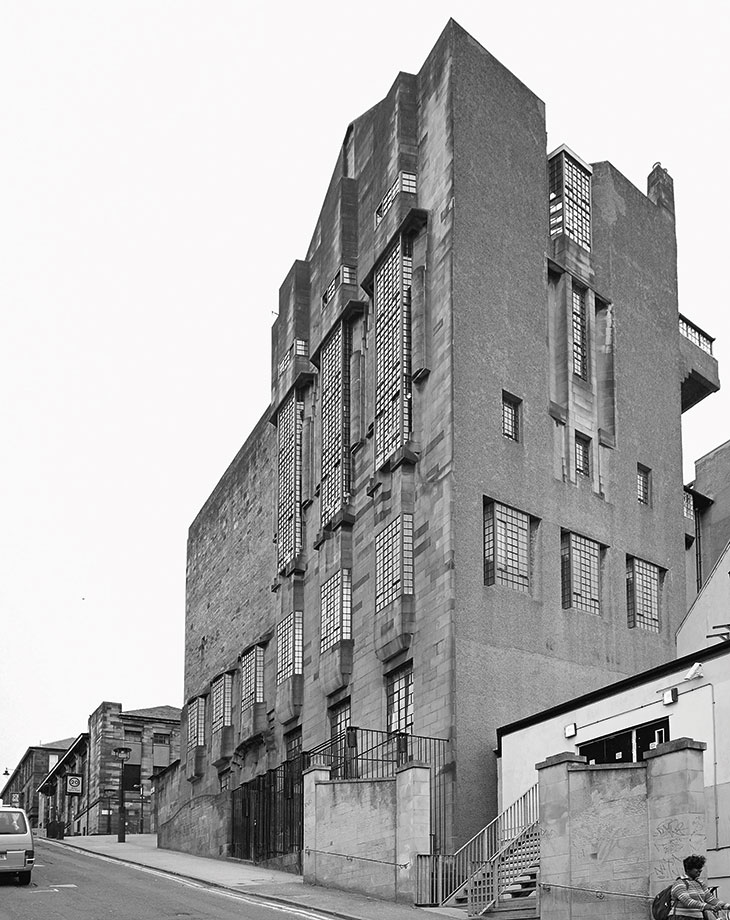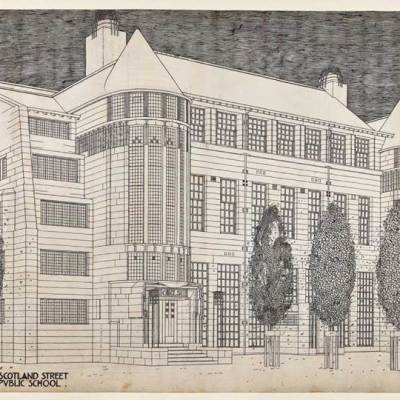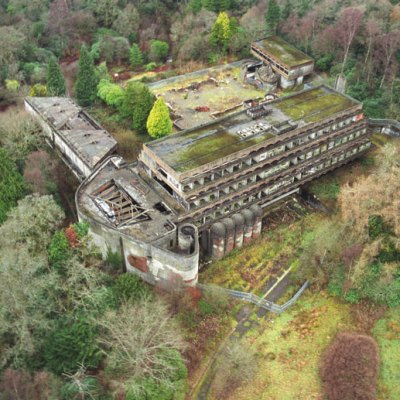When I wrote an article for this magazine recently on Charles Rennie Mackintosh, to coincide with the 150th anniversary of his birth, I had no idea that my description of the Glasgow School of Art would suddenly come to read as an obituary. As I write this, two days after a huge fire swept through the – thankfully unoccupied – building, a mere four years since a previous fire at the 2014 degree show, there is no indication if anything of the building can be salvaged: it is clear that the entire interior is lost, and the walls now perch precariously without restraint, and may well need to be pulled down.
The building plays a role in so many of my memories. As a child I knew it as an icon of Glasgow, the art nouveau masterpiece, even if I had no idea what art nouveau was. At school it was a glamorously elite institution, aspirational but distant; ‘You won’t get in if you aren’t posh and English,’ a cynical art teacher once told us. I gradually crept closer, however: before university we would go clubbing at the Vic Bar student union across the road, the Mack looming in the dark as we stumbled down to Sauchiehall Street at 3am, a silent partner in my young adulthood.
Exterior of the library block of the Glasgow School of Art. completed in 1909 (photo: 2011). Photo: © John Barr/RIBA Collections

Eventually, I studied at the Mackintosh School of Architecture, and spent three years of my life in a 1970s building designed by Mackintosh’s old firm, Keppie’s. It was an unloveable concrete submarine with sagging floors that at least allowed us to look out at its glorious neighbour, but across the road, up the sweeping stairs and into the tight and gloomy lobby, it was another world. The smell of paint, the creaking timber of the floors, the constant comings and goings of the students carrying materials, or taking breaks in the nooks and niches scattered everywhere, it possessed a remarkably vivid sense both of history and of life.
And it was an incredible architectural environment: the sudden passages from dark into light, the ‘Glasgow Marble’ polished-cement render, the odd references to castles throughout, like the portcullis-like ironwork at the top of the staircases; it was all bizarre, fascinating, and wonderful. Besides the main studios to the front there was a remarkable variety of other spaces, from cavernous top-lit studios on the upper floors, to a tiny greenhouse room that cantilevered out precipitously, home to one painting student when I was there and – apparently – a small cannabis farm in the 1960s.
I remember life-drawing classes in the basement, and packed Friday lectures in the stern hall in the base of the building spilling back out on to Scott Street afterwards. I had a girlfriend who was a painter, and I can recall us hanging out in the bay windows near the Hen Run, looking out over Glasgow’s roofs and trying to ignore the tourists who stared at us as though we were living exhibits. In later years I went back now and then, occasionally to lecture, and in one case visiting the library in a spare hour during a press visit to the newly opened Reid Building across the road, just months before it was first destroyed.
This all makes it sound like it is a real person who has died, and in a strange way that’s not far off. The sheer idiosyncrasy of the building, Mackintosh’s care and attention to detail, and its rich intellectual subtexts and simple vital presence gave it more personality – its own and its creator’s – than almost any building I’ve ever experienced.
Interior view of the library of Glasgow School of Art, photographed in 1910 by Harry Bedford Lemere. © RCAHMS

But what could come next? It seems likely it will have to be demolished, in which case there will be very difficult decisions to be made. I would have thought that selling the land for flats would be politically indigestible so, barring surprises, the Art School will probably still occupy the site afterwards. Perhaps a completely new building is in order, but they will have to do better than the somewhat underwhelming Reid Building by Steven Holl built in 2014, and even a brilliant replacement is extremely unlikely to be of remotely comparable architectural quality as the Mack.
If the façade can be restored, then a new building could be built within to contemporary specifications, with perhaps a few very specific moments, such as the library, rebuilt faithfully (for the third time). On the one hand this could be an incredible opportunity, with ruin projects such as David Chipperfield’s new-old restoration of the Neues Museum in Berlin as guiding lights. However, considering local procurement practices, such a project is more likely to end up as one of those hideous examples of ‘façadism’, with something completely banal slotted in behind skin-deep historic character, a farcical travesty of a homage. Personally I simply hope that public understanding of the building’s global cultural value will add the necessary pressure to create something of quality for the future – but the building as it was is gone for good.
One other thing to note is the long and depressing tradition in Glasgow of empty buildings just ‘going on fire’ in the middle of the night. It will be very interesting to hear what, if anything, the Fire Brigade find out about the cause of the blaze. One hopes that nobody would be awful enough to destroy deliberately something so culturally and financially valuable to Glasgow, but we don’t yet and may well never know.



